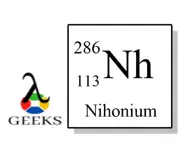Nihonium is a synthetic element discovered not so long before and is named after Japan in Japanese. Let us study more facts in details about nihonium below.
Nihonium is the heaviest element in boron family is placed at the last. It is a radioactive element that decays very quickly. The properties differ than the second most heaviest element in group 13 ( B, Al, Ga, In, Tl, Nh) due to spin orbit interaction. It has almost similar atomic size as that of thallium.
Nihonium can by synthesized artificially by nuclear reaction in recoil chamber. Let us study more properties like size, group, block of nihonium below.
Nihonium symbol
The atomic symbol or chemical symbol is Nh named after Japan which in Japanese is called Nihon.

Nihonium group in periodic table
Nihonium is a group 13 element that belongs to boron family with 3 valence electrons.
Nihonium period in periodic table
Nihonium is a 7th period element in the periodic table placed at the bottom of a periodic table.
Nihonium block in periodic table
Nihonium is a p-block element with outermost electronic state as 7s2 7p1 and last electron in p shell.
Nihonium atomic number
The atomic number of nihonium element is 113. It has 113 protons in the nucleus which are positively charged.
Nihonium atomic weight
The atomic weight of nihonium is 286 µ. It is also called mass number and counts for the total number of neutrons and protons.
Nihonium Electronegativity according to Pauling
The electronegativity of nihonium according to Pauling scale is not yet estimated or predicted as it is a radioactive element with short lifetime.
Nihonium atomic density
The density of nihonium is predicted to be around 16 g/cm3. It is a heavy radioactive element.
Nihonium melting point
The melting point of nihonium is estimated to be 480 0C or 700 K which is comparatively lower as compared to its heavy form.
Nihonium boiling point
The boiling point of nihonium is 1130 0C or 1430 K as predicted due to its radioactive nature.
Nihonium Van der Waals radius
The Van de Waals radius of nihonium is not estimated yet due to its radioactive nature. Its atomic radius is found to be 170 pm empirically.
Nihonium ionic/covalent radius
The covalent radius of nihonium is predicted to be 172-181 pm as found by extrapolating the graph.
Nihonium isotopes
Isotopes are chemical forms of element with same number of protons but differ in the number of neutrons in the nucleus. Let us check in details below.
Nihonium has no stable isotopes with longer half lifetime that occurs naturally. Eight synthetic isotopes are found which are listed below.
| Isotopes | Abundance |
|---|---|
| 278Nh | synthetic |
| 282Nh | synthetic |
| 283Nh | synthetic |
| 284Nh | synthetic |
| 285Nh | synthetic |
| 286Nh | synthetic |
| 287Nh | synthetic |
| 290Nh | synthetic |
Nihonium electronic shell
Electronic shell is a scientific chemical notation of how the electrons are distributed in the orbits of an element. Let us discuss in details below.
The electronic shell of nihonium is found to be 2, 8, 18, 32, 32, 18, 3. It follows Hund’s rule and Aufbau’s principle.
Nihonium energy of first ionization
The first energy of ionization of nihonium is found to be 705 kJ/mol for removing first electron from 7p shell.
Nihonium energy of second ionization
The second energy of ionization of nihonium is found to be 2240 kJ/mol for removing electron from filled 7s orbital.
Nihonium energy of third ionization
The third energy of ionization of nihonium is estimated to be nearly 3020 kJ/mol. It is the highest among all 3 energies.
Nihonium oxidation states
The oxidation states shown by nihonium are +1, +3, +5 and -1. out of which +1 and +3 are most commonly observed.
Nihonium electron configurations
The electronic configuration of nihonium is 1s2 2s2 2p6 3s2 3p6 3d10 4s2 4p6 4d10 5s2 5p6 4f14 5d10 6s2 6p6 5f14 6d10 7s2 7p1.
Nihonium CAS number
The CAS number of nihonium is 54084-70-7. This number is unique for Nh to find properties and facts in database search.
Nihonium ChemSpider ID
The ChemSpider ID of nihonium is not yet found or estimated.
Nihonium allotropic forms
Allotropes are different chemical forms of an element that exists due to different crystalline arrangement of atoms. Let us study in details below.
Nihonium is found to have no allotropic forms so far as it is a radioactive element with very short lifetime.
Nihonium chemical classification
The chemical classification of nihonium in periodic table is stated as
- Nihonium is a radioactive solid element
- Nihonium is a synthetic chemical element
- Nihonium is transactinide element.
Nihonium state at room temperature
Nihonium state at room temperature is predicted to be solid. It is due to its heavy atomic number and hcp crystal structure.
Is nihonium paramagnetic?
Paramagnetic are materials that show paramagnetism phenomenon due to the presence of unpaired electrons. Let us study in details below.
Nihonium is a paramagnetic material as it has 1 unpaired electron in 7p orbital. The magnetic dipole moment vectors align themselves in the field of external magnetic field applied and show paramagnetic character.
Conclusion
Nihonium is a paramagnetic radioactive element that is formed synthetically. It is named after Japan and it is the last element to be placed in Boron’s family.
Read more following properties

Hello…. I am Nandita Biswas. I have completed my master’s in Chemistry with a specialization in organic and physical chemistry. Also, I have done two projects in chemistry- One dealing with colorimetric estimation and determination of ions in solutions. Others in Solvatochromism study fluorophores and their uses in the field of chemistry alongside their stacking properties on emission. I am working as a Research Associate Trainee in Medicinal Department.
Let’s connect through LinkedIn-https://www.linkedin.com/in/nandita-biswas-244b4b179